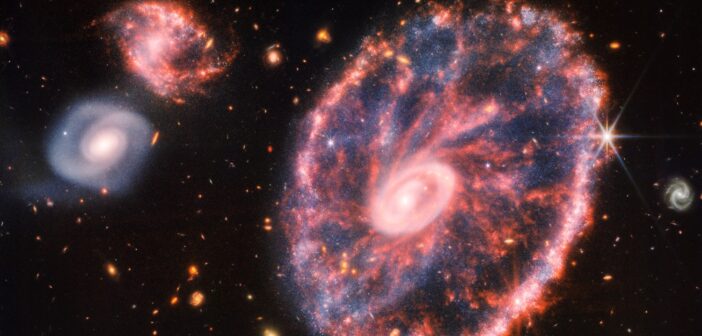JWST has given us a new look at galaxies as they were in the first few billion years of the universe. Among the newly discovered galaxies is a population of flat, red, extended disks that may have been entirely missed by previous surveys.
Dusty Galaxies in the Distant Universe
To understand how today’s galaxies came to be as they are, we need to study galaxies in the distant past. Among the galaxies we know to have existed at redshift (z) greater than 2 — up to when the universe was a little more than 3 billion years old — are massive, dusty galaxies forming stars at a furious rate.

JWST has the potential to reveal galaxies that were invisible to Hubble, like the red galaxy shown here. Click to enlarge. [Adapted from Nelson et al. 2023]
JWST Spies Hidden Galaxies
In a recently published article, a team led by Erica Nelson (University of Colorado) has reported on their analysis of JWST observations from the Cosmic Evolution Early Release Science (CEERS) Survey. This survey was conducted at infrared wavelengths of a few microns (1 micron = 10-6 meter). The same field of view surveyed by CEERS was also visited by the Hubble Space Telescope during the Cosmic Assembly Near-infrared Deep Extragalactic Legacy Survey (CANDELS), though Hubble viewed the area at shorter wavelengths.
Nelson and collaborators noticed that the new JWST images contained galaxies that were absent in the Hubble images of the same region. By selecting for galaxies with certain color characteristics, the team picked out 26 galaxies that were bright in the JWST images but missing in the Hubble images. Among these newfound galaxies are a dozen that are remarkably extended rather than compact — a potentially unexplored population of galaxies present 1–3 billion years after the Big Bang.
Red Through and Through

Comparison of the colors of the newly discovered ultra-red flattened objects (UFOs; red circles) and other galaxies at a similar redshift (black points). Redder galaxies are found at higher F227W-F444W values. [Nelson et al. 2023]
Second, these galaxies are remarkably flat, and they appear to be seen nearly edge on. Nelson and collaborators suggest that the color criteria they used to select the galaxies might be biased toward edge-on, dusty galaxies, which would appear redder than their face-on counterparts. The team notes that galaxies in this size and mass range would be expected to evolve into the massive galaxies we see today, but their lack of a distinct central bulge of stars is surprising. Luckily, spectroscopy, radio-wavelength observations, and simulations all have the potential to improve our understanding of these curious galaxies.
Citation
“JWST Reveals a Population of Ultrared, Flattened Galaxies at 2 ≲ z ≲ 6 Previously Missed by HST,” Erica J. Nelson et al 2023 ApJL 948 L18. doi:10.3847/2041-8213/acc1e1

